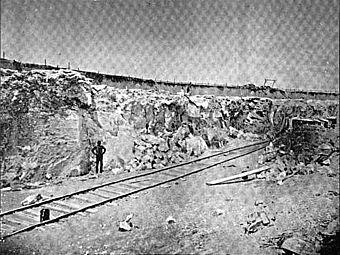Alabaster Historic District facts for kids
Quick facts for kids |
|
|
Alabaster Historic District
|
|

Quarry, c. 1904
|
|
| Location | Bounded by Lake Huron, Gypsum, Keystone, and Rempert Rds., Alabaster, Michigan |
|---|---|
| Area | 400 acres (160 ha) |
| Built | 1861 |
| Built by | United States Gypsum Co. |
| NRHP reference No. | 77000715 |
| Added to NRHP | December 16, 1977 |
The Alabaster Historic District is a special place in Iosco County, Michigan. It's a large area, about 400 acres, focused on an open pit mine where a mineral called gypsum is dug out. This historic area is next to Lake Huron. It's also bordered by Gypsum Road, Keystone Road, and Rempert Road. Mining started here way back in 1862. In 1977, it was added to the National Register of Historic Places. Gypsum from this mine was even used to build temporary structures for the World's Columbian Exposition in Chicago in 1893. The Alabaster Mining Company still operates here today!
Contents
What You'll Find at Alabaster
The Alabaster Historic District sits right on the shore of Lake Huron. It has a huge open pit gypsum mine. Around the mine, you'll see buildings for processing the gypsum. There are also shops and offices.
The district also includes a "company town." This is where the workers lived. Most of the houses were built as 1-1/2-story homes. They were made of wood and had sloped roofs called gables. You can also find a rail line here. There are even remains of a very long elevated tramway. This tramway used to run 1-1/2 miles into Saginaw Bay. In total, the district has 36 buildings across its 400 acres.
The Story of Alabaster's Mine
How Gypsum Was Found
This area got its name, "Alabaster," from a type of gypsum. This gypsum was first found offshore in 1837. It was discovered by a person named Douglass Houghton. Soon, people started looking for more gypsum nearby. They found large deposits right at this site.
These deposits caught the eye of George B. Smith. His father, B.F. Smith, owned a gypsum mill in Detroit. George Smith bought the land. He then opened the mine in 1862.
Rebuilding After a Fire
Sadly, George Smith passed away soon after. His father, B.F. Smith, then bought a big part of the company. By 1891, the company was known as Western Plaster Works. A fire in 1891 destroyed all the mining buildings. But the company quickly rebuilt everything.
Supplying the "White City"
The Alabaster Mine played a big role in a famous event. It supplied material for the main buildings of the World's Columbian Exposition in Chicago in 1893. These buildings were known as the "white city."
A Company Town Grows
In 1898, the company changed its name to the Alabaster Company. Then, in 1902, the mine became part of the U.S. Gypsum Corporation. Many houses for workers were built around 1910. This is when the company town was truly established. Many European immigrants came to work in these mines in the late 1800s and early 1900s.
The Big Tramway
One of the most impressive structures was an elevated marine tramway. It was built in 1929. This tramway was taken down in the 1990s. The mine is still working today (as of 2016).





